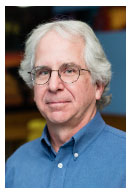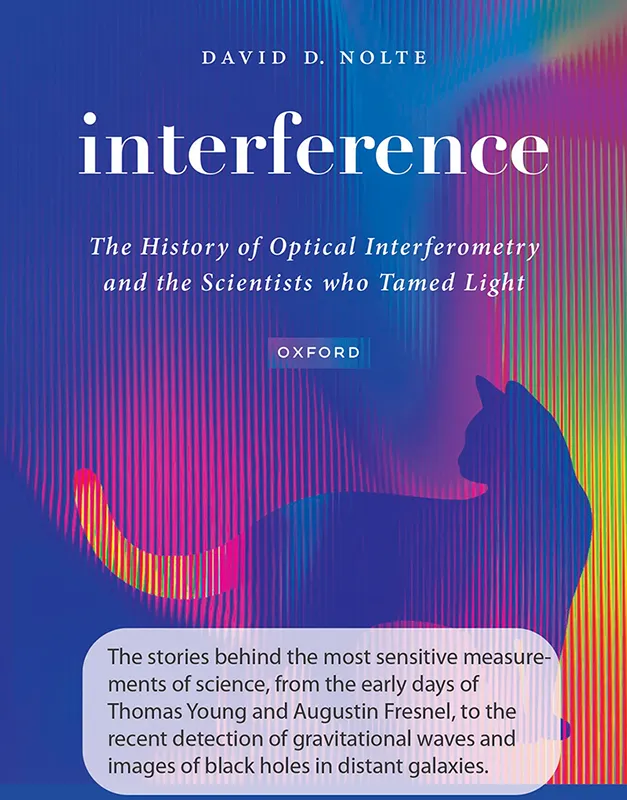Dr. David D. Nolte publishes new book with Oxford University Press
2023-08-29

Dr. David D. Nolte’s latest book, Interference: The History of Optical Interferometry and the Scientists Who Tamed Light, was recently published by Oxford University Press.
Professor Nolte’s book is the first comprehensive history written about interferometry, a central scientific technique that is used in science and engineering labs across the world. Interference is a nontechnical book that tells the stories of the scientists who developed optical interferometry, sometimes at great personal cost, shedding light on how scientists do what they do, and what they have to overcome, to discover and invent new things.
Professor Nolte explains, “Optical interferometry uses the wavelength of light, about a millionth of a meter, as a ruler to measure the sizes of the astronomically large (the diameters of stars) and the sizes of the astronomically small (the displacements caused by gravitational waves). It does this by comparing the peaks and troughs in one light wave to another, creating one of the most sensitive measurement techniques ever devised.”
Dr. Nolte’s writing style blends history, science, and non-technical language that appeals to both general-interest readers and multiple academic disciplines.

Author’s Description of Interference
Ever wonder why soap bubbles become invisible right before they pop? Or why lenses are so blue they look purple? How is it possible to image black holes at the heart of distant galaxies? The answer to all these questions is Interference. This book tells the story of the science of optical interferometry - mankind's most sensitive form of measurement - and of the scientists who tamed light to make outstanding discoveries, from lasers and holograms to astronomy and quantum physics.
In the past several years, interferometry has been used to discover exoplanets orbiting distant stars, to take the first image of a black hole, to detect the first gravitational waves, and to create the first programmable quantum computer. This list of achievements points to the fertile and active field of interferometry for which this book provides a convenient and up-to-date guide for a wide audience interested in the science of light.
Purchase the book
Interference: The History of Optical Interferometry and the Scientists Who Tamed Light by David D. Nolte is available for purchase on Amazon.
About the Author
David D. Nolte is the Edward M. Purcell Distinguished Professor of Physics and Astronomy at Purdue University. He received his BA from Cornell University in 1981 and his PhD from the University of California at Berkeley in 1988, was a post-doctoral member of AT&T Bell Labs. He is a Fellow of the Optical Society of America, a Fellow of the American Physical Society, and a Fellow of the American Association for the Advancement of Science.
For more information about Dr. Nolte’s books, research, and teaching, view his website.
About the Department of Physics and Astronomy at Purdue University
Purdue Department of Physics and Astronomy has a rich and long history dating back to 1904. Our faculty and students are exploring nature at all length scales, from the subatomic to the macroscopic and everything in between. With an excellent and diverse community of faculty, postdocs, and students who are pushing new scientific frontiers, we offer a dynamic learning environment, an inclusive research community, and an engaging network of scholars.
Physics and Astronomy is one of the seven departments within the Purdue University College of Science. World-class research is performed in astrophysics, atomic and molecular optics, accelerator mass spectrometry, biophysics, condensed matter physics, quantum information science, particle and nuclear physics. Our state-of-the-art facilities are in the Physics Building, but our researchers also engage in interdisciplinary work at Discovery Park District at Purdue, particularly the Birck Nanotechnology Center and the Bindley Bioscience Center. We also participate in global research including at the Large Hadron Collider at CERN, many national laboratories (such as Argonne National Laboratory, Brookhaven National Laboratory, Fermilab, Oak Ridge National Laboratory, the Stanford Linear Accelerator, etc.), the James Webb Space Telescope, and several observatories around the world.
Written by: Andrew Robison, Assistant Department Head of Purdue Physics and Astronomy